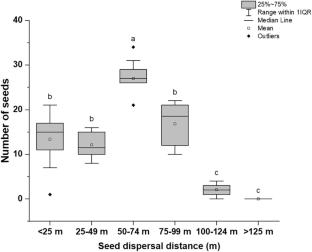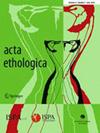Fruit scent as an indicator of ripeness status in ‘bat fruits’ to attract ‘fruit bats’: chemical basis of chiropterochory
Abstract
Abstract
In the tropics, animal-mediated seed dispersal is the most frequently occurring dispersal syndrome, which includes traits that aid in attracting both diurnal and nocturnal dispersers. However, some plants bear fruits with special traits that make them less conspicuous to diurnal frugivores to make them exclusively available to nocturnal frugivores such as bats, which are called ‘bat fruits’. Since these fruits remain drab green in colour throughout their phases of ontogeny, the difference in scent compounds is predicted to help bats to assess their ripeness status. In this study, we specifically examined the behavioural repertoires associated with fruit removal such as ‘search latency’ and ‘number of attempts’ taken by two small-sized fruit bats (Cynopterus sphinx and Rousettus leschenaulti) that feed ex situ and a large-sized fruit bat (Pteropus giganteus) that feed in situ on a bat fruit (Madhuca indica). No fruit was removed on the ‘first’ attempt itself by both the bats; instead, they made multiple (two to six) repeated search attempts to the same bunch of fruits, which is presumably a behavioural mechanism underlying assessing the ripeness status to increase the chance of removal of ripe fruits. The emission of scent compounds was examined using a high-sensitivity headspace proton-transfer-reaction mass spectrometer in real time without any pre-treatment. As predicted, the fruits at the predispersal (unripe) and dispersal (ripe) phases differed significantly from each other in terms of concentration (intensity) of volatile compounds although no difference was inferred in terms of their composition. This study, thereby, highlights the underlying chemical basis of the foraging behaviour of fruit bats while foraging on bat fruits that finally effectuate its seed dispersal (chiropterochory).


 求助内容:
求助内容: 应助结果提醒方式:
应助结果提醒方式:


